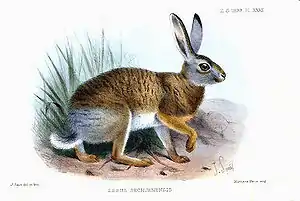< Reconstruction:Proto-Sino-Tibetan
Reconstruction:Proto-Sino-Tibetan/b-jəw-n ~ bwəj
Proto-Sino-Tibetan
Etymology
- Proto-Sino-Tibetan: *yəw+śɑ ("animal (prefix) + rat") (Chou, 1972)
- Proto-Tibeto-Burman: *b-yəw-n ("rat / rabbit / hare"), *bwəy ("bamboo rat") (Matisoff, STEDT); *b-yuw, *b-yəw (Benedict, 1972; Chou, 1972)
The *-n here is said to function as a collective plural suffix (STC).
Descendants
- Chepangic:
- Chepang: युः (yuʔ, “mouse, rat”)
- Old Chinese: 鼬 /*lu-s/ (?) (B-S, unlisted), /*lɯwɢs/ (ZS) (“weasel”); 㕙 /*sʰlun/, /*sʰluns/ (ZS) (dialectal) (“hare”) (as in 東郭逡/东郭逡, 東郭㕙/东郭㕙) (per Matisoff, Schuessler)
- Kamarupan
- Himalayish
- Tangut-Qiang
- rGyalrongic
- Situ: pəɟu (“mouse, rat”)
- rGyalrongic
- Jingpho-Asakian
- Jingpho
- Jingpho [Kachin]: yu (“rat”)
- Jingpho
- Lolo-Burmese-Naxi
- Proto-Karen: *jowᴮ (“mouse, rat”) (Luangthongkum, 2013)
See also
- *rwak (“rat”)
This article is issued from Wiktionary. The text is licensed under Creative Commons - Attribution - Sharealike. Additional terms may apply for the media files.

